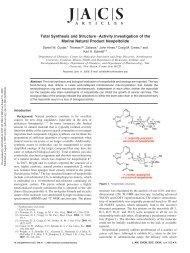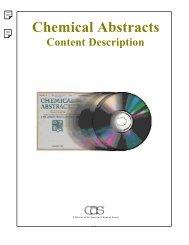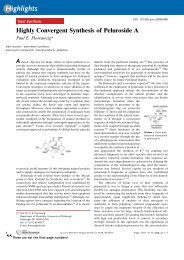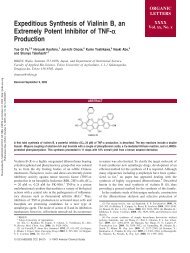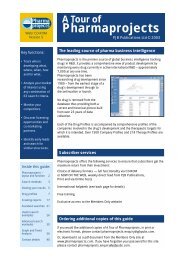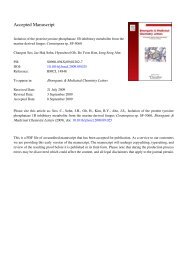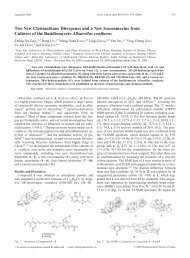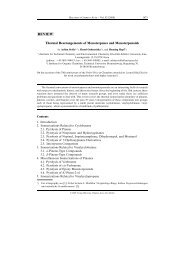Synthesis of Fluorinated Brassinosteroids Based on Alkene Cross ...
Synthesis of Fluorinated Brassinosteroids Based on Alkene Cross ...
Synthesis of Fluorinated Brassinosteroids Based on Alkene Cross ...
Create successful ePaper yourself
Turn your PDF publications into a flip-book with our unique Google optimized e-Paper software.
Downloaded by SHANGHAI INST OF ORG CHEM <strong>on</strong> September 7, 2009 | http://pubs.acs.org<br />
Publicati<strong>on</strong> Date (Web): August 31, 2009 | doi: 10.1021/jm900495f<br />
B Journal <str<strong>on</strong>g>of</str<strong>on</strong>g> Medicinal Chemistry, XXXX, Vol. XXX, No. XX Eignerova et al.<br />
obtained. The structure <str<strong>on</strong>g>of</str<strong>on</strong>g> trans-9c was unequivocally c<strong>on</strong>firmed<br />
by a single crystal X-ray analysis.<br />
Because compounds 9a-9c possess two double b<strong>on</strong>ds<br />
within the molecule, simultaneous dihydroxylati<strong>on</strong> was attempted.<br />
The hydroxylati<strong>on</strong> <str<strong>on</strong>g>of</str<strong>on</strong>g> the double b<strong>on</strong>ds was carried<br />
out by catalytic amount <str<strong>on</strong>g>of</str<strong>on</strong>g> OsO 4 (15 mol %) and excess<br />
N-methyl morpholine N-oxide (3.5 fold excess). 13 Initial<br />
hydroxylati<strong>on</strong> <str<strong>on</strong>g>of</str<strong>on</strong>g> 9a for 2 h led <strong>on</strong>ly to a 1/1.5 mixture <str<strong>on</strong>g>of</str<strong>on</strong>g><br />
10a and 11a in 50% isolated yield. The previous findings<br />
clearly dem<strong>on</strong>strated that dihydroxylati<strong>on</strong> takes place preferentially<br />
<strong>on</strong> the more electr<strong>on</strong>-rich double b<strong>on</strong>d in the<br />
cyclohexane ring. To achieve full c<strong>on</strong>versi<strong>on</strong>, the hydroxylati<strong>on</strong><br />
time was prol<strong>on</strong>ged to 16 h. Under these c<strong>on</strong>diti<strong>on</strong>s,<br />
9a-9c were fully c<strong>on</strong>verted to tetraols 11a-11c that were<br />
isolated as single diastereoisomers in good isolated yields <str<strong>on</strong>g>of</str<strong>on</strong>g><br />
68, 50, and 46%, respectively. The observed dihydroxylati<strong>on</strong><br />
diastereoselectivity could be explained as follows: in case <str<strong>on</strong>g>of</str<strong>on</strong>g><br />
Figure 1. <str<strong>on</strong>g>Brassinosteroids</str<strong>on</strong>g> 1a-1c with perfluoroalkylated side chain.<br />
Scheme 1. C<strong>on</strong>structi<strong>on</strong> <str<strong>on</strong>g>of</str<strong>on</strong>g> Perfluoroalkylated 28-Norbrassinosteroid<br />
Side Chain<br />
Scheme 2. <str<strong>on</strong>g>Synthesis</str<strong>on</strong>g> <str<strong>on</strong>g>of</str<strong>on</strong>g> <str<strong>on</strong>g>Brassinosteroids</str<strong>on</strong>g> with Perfluoroalkylated Side Chains<br />
the cyclohexene ring, an oxidizing agent is approaching the<br />
double b<strong>on</strong>d from the less hindered side, i.e., from the<br />
bottom side <str<strong>on</strong>g>of</str<strong>on</strong>g> the molecule, and in the case <str<strong>on</strong>g>of</str<strong>on</strong>g> the side chain<br />
double b<strong>on</strong>d it is c<strong>on</strong>trolled by the presence <str<strong>on</strong>g>of</str<strong>on</strong>g> the center <str<strong>on</strong>g>of</str<strong>on</strong>g><br />
chirality <strong>on</strong> C-20. Although the formati<strong>on</strong> <str<strong>on</strong>g>of</str<strong>on</strong>g> other possible<br />
diastereoisomers can not be excluded, they were not detected<br />
in the reacti<strong>on</strong> mixture.<br />
Finally, the synthesis was completed by Baeyer-Villiger<br />
oxidati<strong>on</strong> <str<strong>on</strong>g>of</str<strong>on</strong>g> 11a-11c by trifluoroperacetic acid (prepared by<br />
mixing trifluoroacetic anhydride and hydrogen peroxide in<br />
dichloromethane) under ambient c<strong>on</strong>diti<strong>on</strong>s. In each case,<br />
the oxidati<strong>on</strong> afforded a mixture <str<strong>on</strong>g>of</str<strong>on</strong>g> two regioisomeric lact<strong>on</strong>es<br />
in 4:1 ratio in favor <str<strong>on</strong>g>of</str<strong>on</strong>g> the desired regioisomers 1a-1c<br />
with natural c<strong>on</strong>figurati<strong>on</strong> <str<strong>on</strong>g>of</str<strong>on</strong>g> diol moiety in the side chain.<br />
The desired brassinosteroids 1a-1c were isolated by preparative<br />
HPLC in 62, 70, and 61% yields, respectively.<br />
Biology. Because the brassinosteroids are known to possess<br />
various biological activities, the newly attained compounds,<br />
1a-1c and 11a-11c, c<strong>on</strong>stituted ideal substrates for testing in<br />
various assays because <str<strong>on</strong>g>of</str<strong>on</strong>g> their new structural and previously<br />
unexplored feature, a perfluoroalkylated side chain.<br />
GABA A Receptors Activity. Initially, the binding <str<strong>on</strong>g>of</str<strong>on</strong>g> the<br />
compounds 1a-1c to GABA A receptors was tested in vitro<br />
using membranes isolated from the brains <str<strong>on</strong>g>of</str<strong>on</strong>g> male Wistar<br />
rats. The specific steroid binding was detected by the decrease<br />
in the binding <str<strong>on</strong>g>of</str<strong>on</strong>g> 2 nM [ 35 S]-tert-butylbicyclo-[2.2.2]<br />
phosphorothi<strong>on</strong>ate (TBPS) after applicati<strong>on</strong> <str<strong>on</strong>g>of</str<strong>on</strong>g> the tested<br />
compounds incubated for 1 h at 37 °C. The results (see<br />
Table 1) could be summarized as follows: the heptafluoro<br />
derivative 1c compares favorably to natural horm<strong>on</strong>e allopregnanol<strong>on</strong>e<br />
12 and its higher metabolic stability (with<br />
respect to potential hydroxylati<strong>on</strong> <str<strong>on</strong>g>of</str<strong>on</strong>g> the side chain) 4,12,13<br />
should more than compensate for its slightly lower GABAlike<br />
activity. The results are in agreement with structural<br />
similarity <str<strong>on</strong>g>of</str<strong>on</strong>g> 1c and 28-norbrassinolide 13 (Figure 2). 13<br />
Compound 1a, which does not c<strong>on</strong>tain the steroidal i-octyl<br />
side chain, is active at a higher c<strong>on</strong>centrati<strong>on</strong> <strong>on</strong>ly and<br />
compound 1b is inactive.



